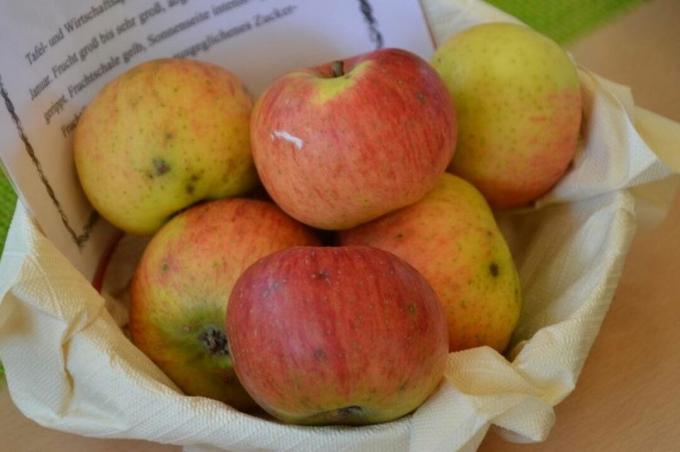Anyone looking for an uncomplicated and versatile apple tree for the home garden or the orchard should take a closer look at the ‘Josef Musch’ variety. We present the undemanding apple variety.

The apple ‘Josef Musch’ is a very recommendable variety for the home garden. In addition to the low demands on soil and climate, the medium-strong growth is an advantage that is particularly useful in small gardens. The fruit from ‘Josef Musch’ is tasty enough to be used as a table apple, but is also very suitable for processing and must. Because the tree is also robust against the cold and pests, ‘Josef Musch’ can rightly be called a worthwhile purchase for the orchard and private garden.
contents
- Josef-Musch-Apple: Profile
- Origin and history
- Taste and properties of the apple ‘Josef Musch’
- Growing and caring for Josef Musch: that's how it works
- Apple variety ‘Josef Musch’: harvest and use
Josef-Musch-Apple: Profile
| Synonyms | 'Pussy' |
| fruit | large to very large; Greenish to straw yellow basic color with a carmine red covering color |
| taste | full-bodied, not very acidic |
| Yield | medium to high, hardly fluctuating |
| Harvest time | Mid-September to October |
| Ripe for enjoyment | from November on |
| Shelf life | Well; storable until February |
| growth | medium strength at the beginning, later weaker |
| climate | low demand |
| Diseases and pests | robust against diseases; prone to comma scale lice |
Origin and history
Joseph Musch discovered the chance seedling and gave its name to the apple variety ‘Josef Musch’. It was first mentioned in writing in 1872 and is presented in detail in the Pomological Monthly Bulletin of 1881. The rambur-shaped fruit is closely related to ‘Baumanns Renette’ and is still successfully grown today, especially at heights.
Taste and properties of the apple ‘Josef Musch’
The fruit of the apple variety ‘Josef Musch’ is large to very large and looks a typical rambur. The shape is flattened spherical and has broad, easily visible edges. The stem is thick and short. Sometimes the halves are unevenly pronounced due to incomplete fertilization. The basic color of the skin is greenish yellow and straw yellow when fully ripe. The bright carmine-red, washed-out and streaky body color develops over almost the entire fruit. The apple can be very rusty, often reticulate patterns and many large rust spots or warts around individual lenticels. The shell is rather coarse and firm. The pulp inside shows clearly visible green vascular bundle lines. It is whitish yellow and coarse-celled, not very crunchy and not very juicy, but has a good, full-bodied taste with little acidity. The ripe Josef Musch apple has a strong smell.

Growing and caring for Josef Musch: that's how it works
The apple tree of the ‘Josef Musch’ variety is a comparatively undemanding wood. Although it prefers nutrient-rich, loamy soils and does not tolerate constantly dry soils very well, it hardly makes any further demands. With sufficient Fertilizing the apple tree the variety does well on almost all garden soils and in different climates.
Especially at altitudes over 500 meters above sea level, ‘Josef Musch ’’s low climate requirement is a frequently used property. Even in cold winds and cool summers, the fruits ripen reliably.
The growth of the variety is medium strong in youth and slows down later. The tree is usually only medium-sized, whereby growth and final size are of course influenced by the base used. The branching of the tree is only weak, so that the crowns tend to be light and aged. A regular cut to maintain vitality is therefore very important at ‘Josef Musch’ in order to always generate young fruit wood that produces high-quality apples.
The variety can be raised as a half-stem, high-stem or shaped fruit - such as espalier fruit.
The bloom appears early to medium early with large petals. As pollinators, the varieties ‘Baumann's Renette‘, ‘Cox orange‘,‘ Croncels ’,‘Yellow Bellefleur‘,‘ Yellow noble apple ’,‘Gold parmane‘, ‘Landsberger Renette‘, ‘Ontario‘And‘ White clear apple ’are suitable. In return, the pollen from ‘Josef Musch’ cannot contribute to the pollination of these varieties because the variety is triploid, so has a triple genetic make-up and is therefore not compatible with diploid varieties like the ones mentioned above. It is therefore better to have two pollinator varieties nearby so that they can also pollinate each other.
Regular fertilization ensures medium to high yields, but if the fertilization is too strong with potassium, there may be a relative calcium deficiency, which then triggers speckling in the fruit. It is therefore very important to use slow-acting, organic fertilizers when fertilizing.
The apple tree ‘Josef Musch’ is very robust against diseases, but according to experience reports it is preferred to be attacked by comma scale insects.
Apple variety ‘Josef Musch’: harvest and use
The apple from ‘Josef Musch’ is ripe for picking from around mid-September, depending on the weather, and the harvest continues into October. Apples picked early are stored and last until February. The fruits in the apple store should be checked regularly, however, because they tend to rot in storage. The Josef Musch apples are ripe for consumption on the tree from November. The use as a table apple is only in second place at ‘Josef Musch’, although the taste is good. Because it makes particularly tasty juices and muse, the apple is mainly used for must and processing.
Those who plant an apple orchard should choose varieties that complement each other. So it is with the varieties ‘Landsberger Renette‘And‘ Josef Musch ’: They are harvested around the same time and the Landsberger Renette is a wonderful, aromatic table apple.
